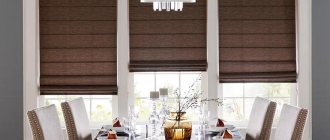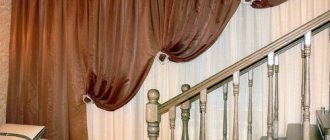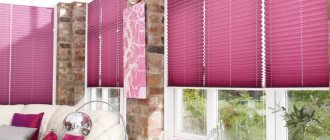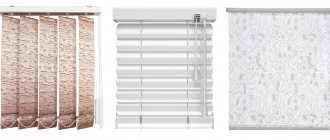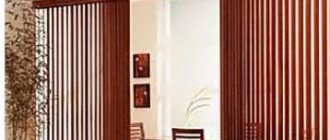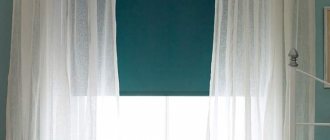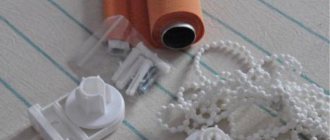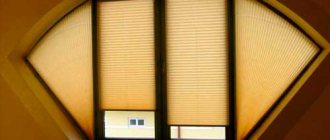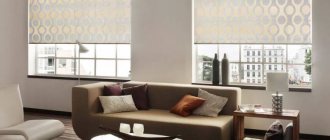Recommendations for choosing roller blinds for a loggia
When choosing roller blinds, you should consider some nuances:
- For small balcony windows, it is better to choose rolled products with large prints and designs, and for large ones, on the contrary, smaller patterns and ornaments are suitable.
- You should not use curtains of too dark colors to design a balcony located on the sunny side, as such curtains will help heat the room.
- For poorly lit balcony spaces, roller blinds made from low-density fabrics are suitable.
Introduction
If you need to choose blinds for a balcony, which ones are best in terms of price and quality? Knowing the basic characteristics of all types of these products will help you.
The beautiful French name “blinds” refers to light-protective window devices, which are horizontal or vertical strips (slats) connected to each other with a special cord. These slats can rotate around to diffuse and regulate the amount of sunlight entering the room. This concept also includes Roman blinds, fabric roller blinds, pleated blinds, fabric and bamboo roller blinds.
When setting yourself the task of choosing blinds for a balcony, you need to take into account their functional purpose for a particular room, the interior of the room, fastenings, material and the very texture of the windows.
Functional purpose of blinds:
- Regulating the sunlight entering the room.
- Air regulation.
- Reducing the room temperature.
- Minimizing the view of the room from the outside.
- Decorating the room.
Lightproofness of roller blinds
Rolled fabrics are divided into several types based on light transmittance:
- Translucent. They have a fairly low density and transmit light well. As a rule, they are more often used as room decor rather than for sun protection.
- Reflective. Thanks to special impregnation, they reflect ultraviolet rays. These models are especially suitable for balconies located on the south side.
- Scattering. They create a slight darkening effect and softly diffuse the light passing through them.
- Day night (zebra). Very popular models. Alternating dense and transparent stripes make it very convenient to adjust the degree of lighting on the loggia and the adjacent room, such as the kitchen, bedroom or living room.
- Complete sun protection. They provide maximum darkness and completely block out sunlight.
In the photo there are white day-night roller blinds on the loggia.
How to install it yourself
It is easy to install the product yourself. It does not take much time and does not require special skills. Many manufacturers include detailed instructions and also include the necessary fasteners.
Let's consider the stages of installing horizontal blinds on a frame:
- Prepare tools: drill, screwdriver.
- Attach the blind rod to the top of the frame and mark where to drill.
- Screw the brackets. To install the cornices of vertical blinds, it is rational to use construction dowels, which are driven in with a special gun.
- We attach the cornice.
- On the lower part of the frame, under the glazing beads, mark the exit points of the fishing line threaded through the slats of the blinds, and drill the same neat holes.
- Remove the plugs from the ends of the planks.
- We remove another round plug, under which there is a unit.
- Remove the bottom bar by untying the two knots.
- We remove excess plates from below if the blinds are too long.
- We attach a plastic rotating mechanism (transparent stick) to the hook.
- Insert the bottom bar and cut off the protruding threads.
- We insert all the pulled out plugs.
- Take a plastic retainer.
- We make markings, drill holes, and fasten the fastener with a screw.
- We fasten the clamp on the other side.
- We insert the bottom bar into the clamps.
- The ends of the fishing line are inserted into the plugs, and the plugs are inserted into the holes in the frame, resulting in tension in the fishing line.
- We check the functionality.
Blinds with vertical slats are attached using a similar technology. Only the mounting location is not the frame, but the wall or ceiling.
Video instructions for installing blinds without drilling:
Canvas material
The main types of fabrics used to make roller blinds:
- Textile. It can be a variety of fabrics, for example: linen, cotton, jacquard or silk. Especially known and popular is such material as blackout. It is used when complete sun protection is needed.
- Blended fabric. It imitates and is no different in appearance from natural analogues, but at the same time significantly exceeds these products in terms of wear resistance.
- Natural materials (jute, bamboo). Durable, practical roller shutters made of jute or bamboo, very easy to care for and highly environmentally friendly, thanks to these qualities
- Polyester/PVC. Moisture-resistant material with a long service life. Products made from polyester perfectly absorb and reflect the sun's rays.
The photo shows multi-colored fabric rolls in the interior of the balcony.
Methods for attaching a cornice to a balcony
Basically, attaching a cornice to a balcony is no different from attaching it in other rooms. This process is not particularly difficult; the main thing is to choose the right fasteners and tools.
You can secure the cornice using:
- anchor bolts (for metal structures);
- dowels;
- liquid nails (to the ceiling).
The material of the rod and the material of the bracket must match. Usually all accompanying elements are included with the cornice. Be sure to check if you have:
- Brackets;
- Consoles for them (i.e. supports);
- Decorative strips and bowls;
- Expansion dowels (standard 8 mm);
- Screws.
If something from this set is missing, you should purchase the necessary elements before starting installation work.
As for the set of tools, you may need:
- drill (with a concrete attachment);
- tape measure and building level;
- pencil or marker;
- Phillips screwdriver;
- hammer;
- stepladder (can be replaced with a durable stool).
It is important to follow safety rules during the installation process. Despite the fact that the work is carried out inside the balcony, you should not leave the window open, and use fragile structures such as wooden boxes, etc. to access the upper part of the window.
Attaching the cornice to the wall
Most often, curtain rods are attached to the wall. Moreover, here there are also two options - mounting on opposite walls or on the same wall using supports.
The procedure is as follows:
- Using a construction pencil or marker and a tape measure, mark the places where the brackets are attached to the wall. The evenness of the marks is checked by the building level;
- Brackets are applied to the marks, and drilling points are marked through the holes for the dowels;
- Holes are drilled at the marked points (the nozzle is selected depending on the type of wall);
- Dowels are inserted into the resulting holes;
- The brackets are again applied to the mounting points and screwed in turn with screws;
- To prevent the screws from being conspicuous and spoiling the appearance of the cornice, the fastening points are covered with a decorative cap (can be glued or screwed with a pair of small screws);
- Next, the bracket post is inserted into the cap and secured with bolts and screws;
- The cornice itself is attached to the stand. It can be left loose, but it is better to secure it with a few screw bolts.
Depending on the design of the cornice, certain nuances may appear during its installation, but in general, these instructions are quite universal.
Useful video instructions:
Attaching a ceiling cornice with liquid nails
Drilling holes for dowels in the ceiling is a labor-intensive task, and it will be difficult for a beginner to cope with it. Therefore, the most popular option for attaching a ceiling cornice is liquid nails.
The procedure is as follows:
- The base of the ceiling at the place where the cornice is attached is cleaned of dirt and dust;
- To improve adhesion, if the ceiling is old, it is better to sand the whitewash, clean off the old paint, then level the surface and apply a layer of primer;
- The renewed surface is degreased, then approximate markings for the placement of the cornice are applied;
- Glue is applied along the entire length of the cornice in zigzag stripes;
- Next, the cornice is pressed tightly against the surface of the ceiling. If the location needs to be adjusted, the product can be carefully moved without lifting it from the ceiling surface;
- The glue sets in 15-20 minutes, complete drying occurs in a couple of days.
There is no need to worry about the strength of the structure secured with liquid nails. This glue can withstand loads of up to 80 kgcm 2. So you can hang both light curtains and heavy thick curtains on the ceiling cornice.
Video instruction:
Color spectrum
When decorating such a small room, the choice of color plays an important role.
Beige
It will add tenderness and comfort to the balcony space. Roller blinds in a beige shade significantly refresh the room and make it much lighter.
The photo shows a balcony and beige roller blinds decorated with floral patterns.
Green
Charges with energy and positivity. Brings amazing cleanliness and extraordinary freshness to the loggia.
White
Will add light, lightness and volume. White roller blinds will look stylish and elegant in any balcony space.
Design and drawings
Roller shutters, decorated with spectacular and original designs, transform the loggia and give it uniqueness.
Flowers and vegetation
Plant and floral motifs form a very delicate and sophisticated design. They add romanticism to the atmosphere of the balcony and create a spring-summer mood. When designing a window with curtains with such a print, first of all you need to pay attention to the size of the balcony or loggia, since large flowers will be more appropriate in a spacious room.
The photo shows a balcony with roller blinds decorated with designs in the form of flowers.
Stripes
A simple, but at the same time very interesting solution. This print is distinguished not only by its aesthetic appeal, but also has the ability to visually adjust the space, making it taller or wider.
Patterns and ornaments
Loggias add contrast and visual interest. Various intricate patterns and ornaments can transform even the most faceless room.
With photo printing
One of the most original design solutions. Photo printing on roller blinds allows you to make your interior bright, colorful and give it a unique and special look. Various images of animals, natural landscapes or cities determine the mood and set a unique, personal style.
Roller blinds for balconies
Rice. 11. example of wooden roller blinds
Roller blinds are assembled into a block, which is located on the eaves. They, as in the case of the horizontal model, are attached directly to the frame, which ensures a tight fit. The curtains are rolled up, hence the name. This twisting is provided by 2 ropes on the sides and a weighting knitting needle at the bottom of the curtains.
Advantages and disadvantages of roller blinds for balconies
Rice. 12. fabric roller blinds
Roller blinds can only be adjusted by raising or lowering the curtain. However, the material that is used for them usually has a small throughput, so even when completely closed, not all models provide complete darkness in the room. As with the horizontal option, a new roll will be required for each window unit. Everything is regulated independently of each other.
Such curtains are usually easy to care for and have the greatest variety in style and design. So they will look very original on the balcony.
Design of non-standard windows
When decorating with roller blinds, it is important to take into account the features of the window frame and the functionality of the window itself.
Roller blinds for a balcony with sliding windows
For the smooth functioning of each sash, it is better to choose models that are attached to the ceiling.
Panoramic glazing
Roller blinds are best suited for such a space that is open to views and sun. Due to their compactness and laconism, when folded they do not spoil the magnificent panoramic view, and when unfolded they perfectly hide the room.
The photo shows white roll models on a loggia with panoramic glazing.
How to choose the right one
When choosing blinds for your balcony, you should focus, first of all, on convenience and compliance with the design of the room.
The stores offer a wide selection of different models.
Plain models are always in demand, but colored options are of particular interest.
Of course, it’s easy to get lost among all this diversity, so I’ll give universal recommendations:
- Horizontal ones - made of plastic - are the simplest and cheapest option.
- White, peach, beige, light gray models will look harmonious with almost any interior.
- Focus on the location of the windows. For those living in the north, blinds made of light, translucent materials are more suitable, and for those living in the south, blinds made of dense materials are more suitable.
- The length of the structure should be 5 cm less than the length of the window frame.
Ideas for mounting location
Also an important role is played by the types of fastening of roller blinds, the most common are:
- On the window frame. It looks very aesthetically pleasing. This mount significantly saves space on the loggia and is a very convenient option for folding plastic windows.
- To the ceiling. Roller blinds with ceiling mounting are suitable for high window openings or for sliding structures.
The photo shows a glazed balcony and brown shutters with an option for mounting to the ceiling.
Types of blinds designs
The design of the blinds for the windows of the apartment and for the balcony are identical. Depending on the design, the curtains can reach the floor or cover only the balcony glazing. Most popular models use rotating slats that allow you to adjust the amount of light flux.
Curtains with horizontal slats
Budget horizontal blinds for a balcony consist of a cornice (with built-in lifting and turning mechanisms), light slats suspended on a network of synthetic thread, and a control cord. Some models are equipped with additional brackets that can fix the bottom edge to the window frame to protect against wind vibrations.
For horizontal structures made of PVC or aluminum, you can also buy magnetic fasteners for the lower edge, which are easy to install.
The main advantage of horizontal models is their unified dimensions, which allow you to install a curtain on each window sash. This is convenient for balconies equipped with glazing with plastic shutters that open inward.
The horizontal design is easy to install on a swing-and-turn sash. The slats do not interfere with any position of the open window, although they lose their functionality. Some models are equipped with perforated slats, which increase the light transmission of closed curtains.
The disadvantages of budget models are:
- low wear resistance of the suspension mesh (the threads wear out with frequent use and break);
- breaks and deformations of the slats (can occur from careless handling or when pets try to get through the curtains);
- industrial appearance (more suitable for business interiors, office design).
It is almost impossible to repair or replace broken and bent slats; the section must be completely replaced. External roller blinds made of durable metal, protecting second-floor balconies from burglary, are rarely installed in CIS cities.
Pleated blinds
The structures, called “pleated”, consist of upper and lower aluminum profiles, with pleated plastic or fabric fixed between them. To change the lighting, the pleated part is raised partially or completely.
The lifting is controlled using a chain, cord, or remotely (miniature electric motors). This design is not popular in our country due to its high cost.
Designs with vertical slats
The main feature of vertical blinds are wide slats that rotate and slide along the eaves. With the help of a rotary-sliding design, you can regulate not only the strength of the light flux, but also take into account the movement of the sun along the horizon. To do this, the lamellas rotate on a vertical axis; they can be installed at any angle to the sunlight.
When choosing vertical blinds for a balcony, you need to focus on the system for opening balcony windows. Models that reach the floor look organic, but they are difficult to use for balcony glazing that opens inward. Short curtains (the size of the window opening inwards) look unnatural. The long model can only be used with the windows closed.
Important: when purchasing a specific model, pay attention to the opening side, right-hand or left-hand. For the assembled curtain, you need to leave some space behind the window opening. Not all balcony glazing frames are suitable for this.
It is difficult to install vertical models on balcony glazing with a wide window sill. In this case, the cornice must be installed on the ceiling.
Roller blinds
Structurally, roller blinds for balconies are more complex than previous models. A design feature is a volumetric cornice (box) with an internal shaft on which a fabric consisting of elastically connected narrow lamellas or dense fabric is wound. A shaft rotation mechanism and guide strips are installed in the cornice box, protecting the twisted fabric from folds and bends.
A new type of roller blind on the balcony is the “zebra” model, consisting of two canvases (transparent and with a pattern). Rolled models, like horizontal ones, are installed on each section of balcony glazing. Roman blinds can be considered a type of roller blinds, which gather into large folds when lifted.
How to attach?
Roller blinds have several types of fastening, which allow them to be placed not only on the window opening, but even on the door, for example, using self-tapping screws, Velcro, plastic or metal spring brackets. Below are step-by-step instructions on how to hang rolls of paper with Velcro:
- Treat the areas of the balcony frame to which the fastening will be made with a special degreaser.
- Heat the adhesive tape with a hair dryer.
- Remove the protective film.
- Press down firmly and glue it to the surface of the glass unit.
Watch another video of curtain installation.
What is a roller blind
Roller blinds are one of the varieties of light-shielding systems in which the canvas is attached to a shaft in the form of a hollow tube fixed in a horizontal position on a bracket. When the shaft rotates, the canvas goes down and closes the window opening, preventing light from entering the room; if the tube is turned in the other direction, the canvas is wound around it and opens the glazing in the sash, letting light into the room.
The material used for roller blinds is a special fabric, which can be dense or translucent; recently, combined materials that operate in day-night mode have become popular among consumers.
Roller blinds are attached to the sash in three main ways:
- on S-shaped plastic brackets, clinging to the top edge of the doors and secured with double-sided tape;
- using self-tapping screws that screw plastic brackets to the door leaf;
- on brackets glued with double-sided tape to a window or door sash, but this method is practically not used due to weak fixation.
Roller blind design

